We will be taking a look at the MSI GTX 1080 Gaming X 8G graphics card. This is a highly popular graphics card from MSI and it features TwinFrozr VI cooling solution to drive the extreme cooling requirements of the card with custom PCB.
This card comes equipped with RGB LED lighting on the top side and static Red LED Lighting on the shroud mounting LEDs. This card has a cold plate for the VRAM and surrounding areas as well as the PWM heatsink with micro fins for better temperatures. The card has one 8-pin and one 6-pin connector to power it up.
MSI has used Military Class 4 grade components in the circuitry. And there is a stylish backplate with a dragon logo and pointy vents for airflow.
Packaging and Unboxing
The graphics card is shipped inside a cardboard-based packing box in MSI typical branding. Their colors are Red and black which are my personal favorite and the majority of my builds have those colors in the main theme.The front side of the box has MSI dragon logo printed on the top left side with MSI printed on its right side. There is a picture of the card showing its shroud in the main section. Gamin X and GeForce GTX 1080 are printed below the picture. The card has 8GB VRAM and DirectX 12 support. It is VR ready as well. The backside of the box has nVidia brand name and logo printed on the top left side. Gaming X is printed on the right side. Salient features of the card like RGB LED, Twin Frozr VI cooling solution, MSI Mystic Lighting, and Gaming App are printed in the main section.
Features of the Pascal chip are printed under it. Salient specifications are printed as well. The card is made in China. The right side of the box has MSI brand logo and name printed on top. There is a sticker pasted in the middle with the Serial No of the card, EAN, and UPC info barcodes printed on it. GeForce GTX 1080 is printed on the bottom. The left side of the box has MSI brand name and logo printed on the top. 8GB GDDR5X, DirectX 12, and VR Ready labels are printed in the middle.
GeForce GTX 1080 is printed on the bottom. The bottom side of the box has salient features of the Pascal chip printed in 20 different languages and it is in the plain black color background. The top side of the box has a red color background. GeForce GTX 1080 is printed on the left side. Gaming X, Twin Frozr VI are printed in the middle and there are an MSI logo and brand name on the right side. Opening the top cover will show the inner cover with the tagline Play Hard, Stay Silent.
Lift this cover to take out the inner box in the black color. The inner box has a container box with MSI brand logo and name embossed on it. It has the provided accessories inside. Taking this container off will show the card placed inside the antistatic bag. The card is tucked inside the dense black color Styrofoam pad.
Accessories
MSI has provided a user guide, installation CD, a comic with title Lucky the Dragon, Computer Workshop.
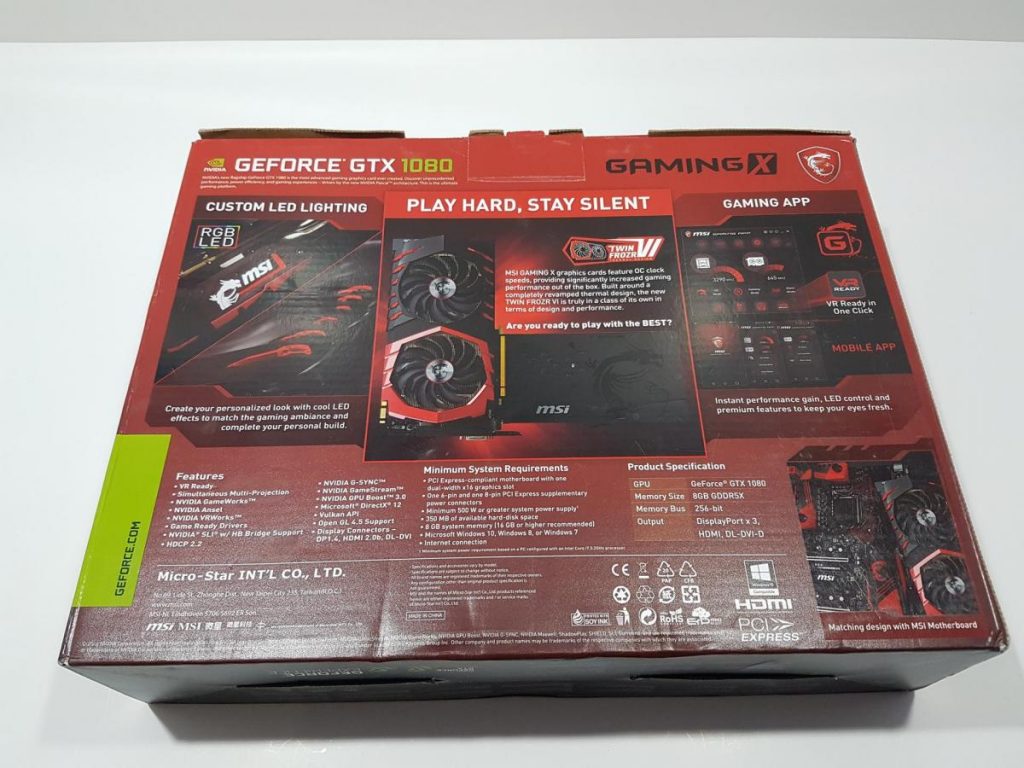


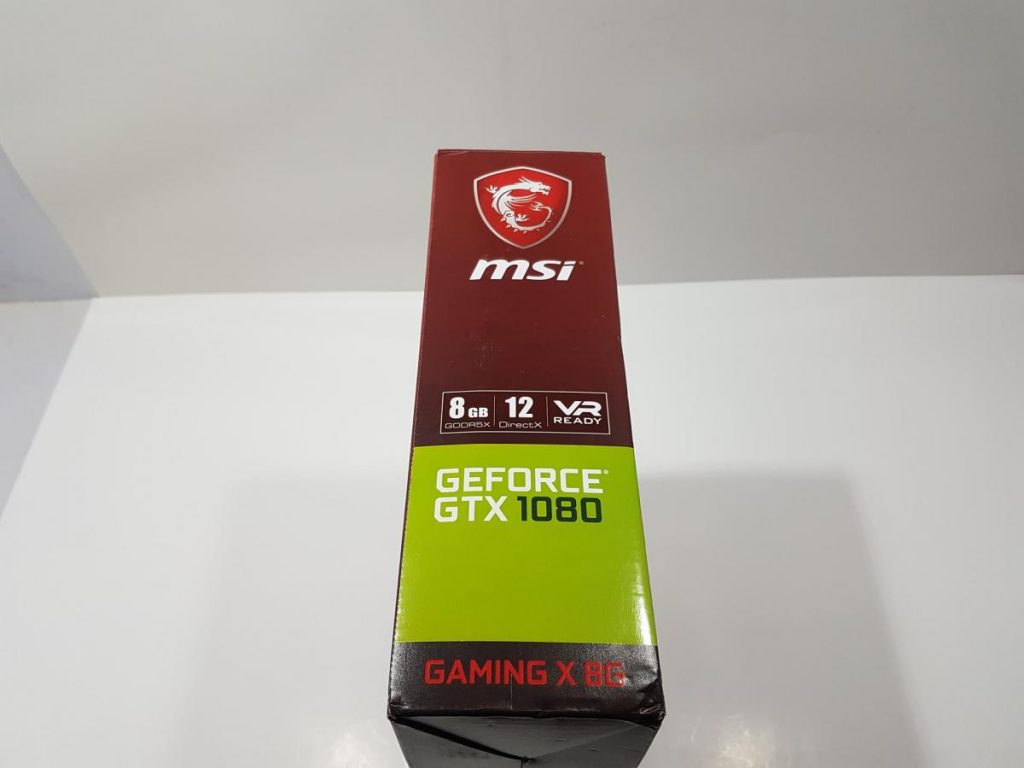
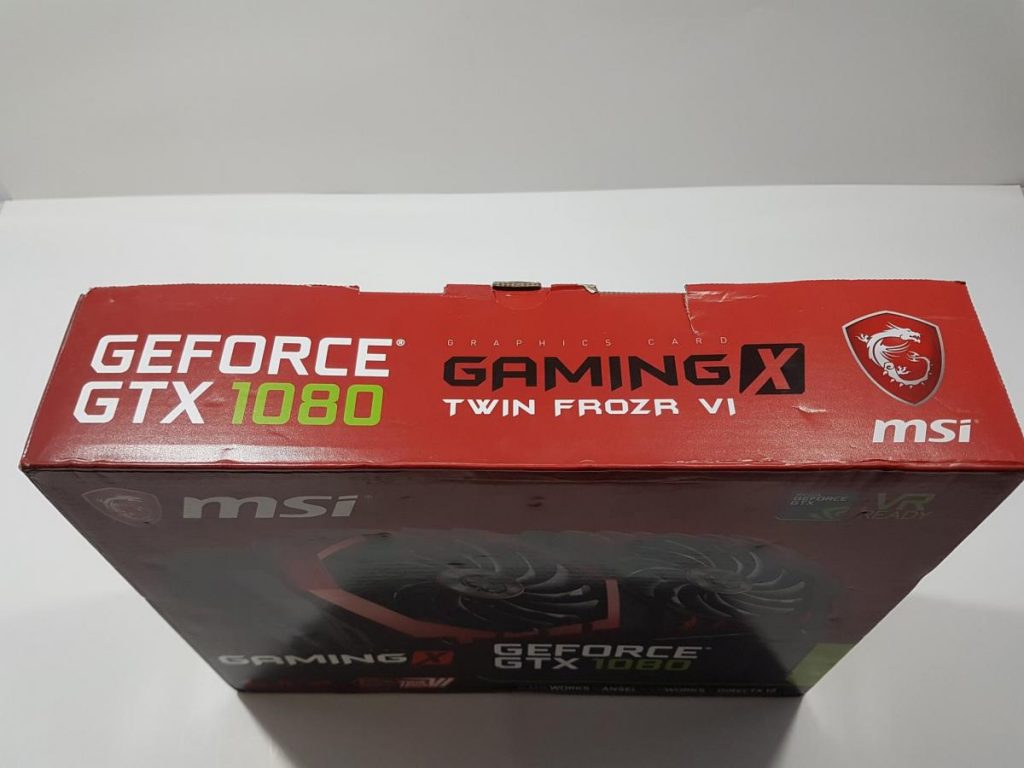
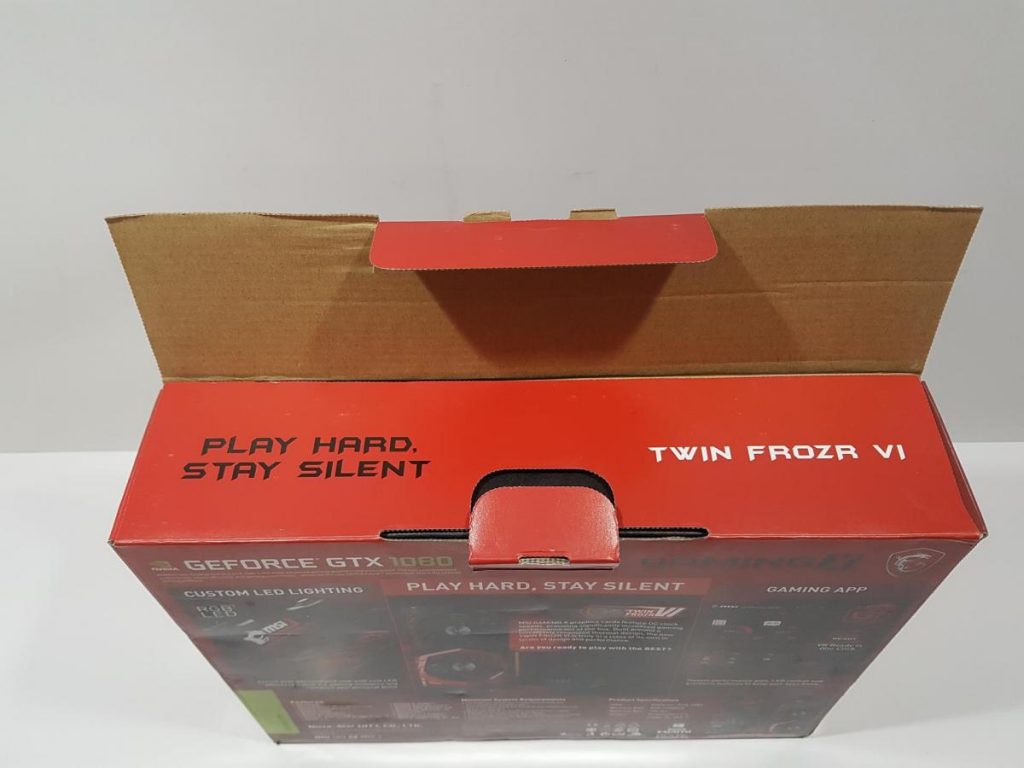
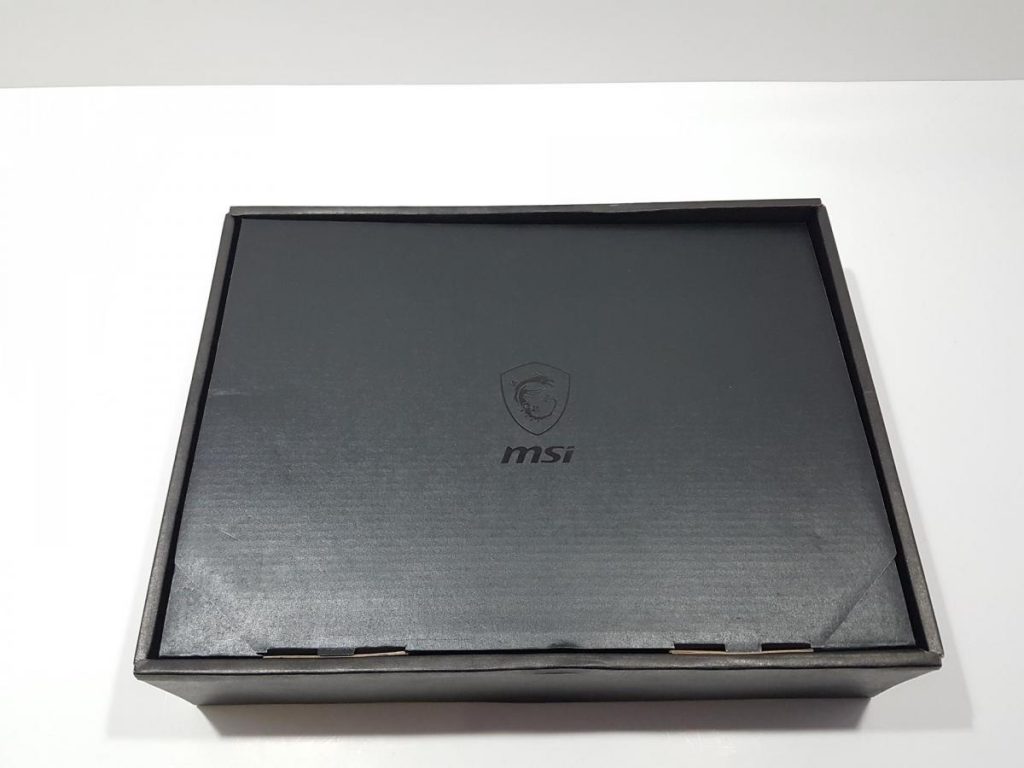
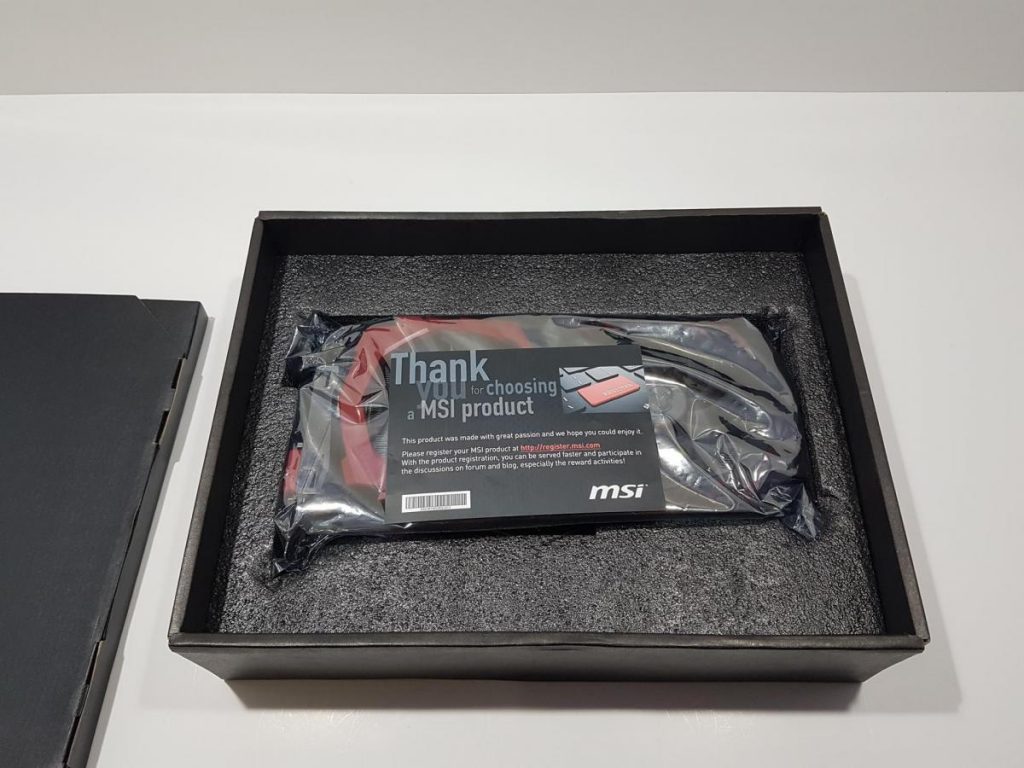


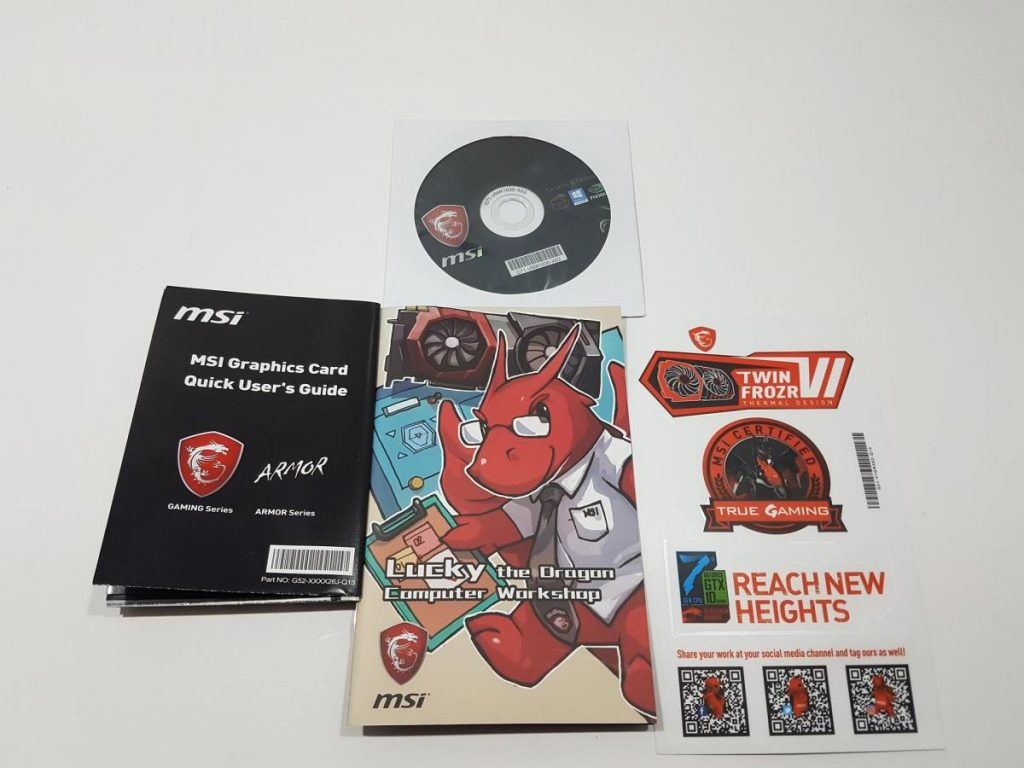
Closer Look
The MSI GTX 1080 Gaming X features nVidia’s Pascal based GP104 chip with 16nm FinFET technology and 314mm² die size. It packs 7200M transistors with 64 ROPs, 160 TMUs with bus interface of PCIe 3.0 x16. It has 2560 unified shaders or compute units. Pixel fillrate is 107.7 GP/s with texture fillrate of 269.3 GT/s. This particular model is using eight 1GB GDDR5X chips from Micron clocked at 1251MHz. Bus width is 256 bit and bandwidth is 320.3 GB/s. The chip is clocked at 1683MHz base clock with 1823MHJz boost clock. There are three modes on this card each with different clocks. These modes can be accessed and controlled using their Gaming App.| Mode | Base Clock (MHz) | Boost Clock (MHz) | Memory Clock (MHz) |
| Gaming Mode | 1683 | 1822 | 10010 |
| OC Mode | 1708 | 1847 | 10108 |
| Silent Mode | 1607 | 1733 | 10010 |
With the numbers taken care off, let’s dig into the design elements of this card.
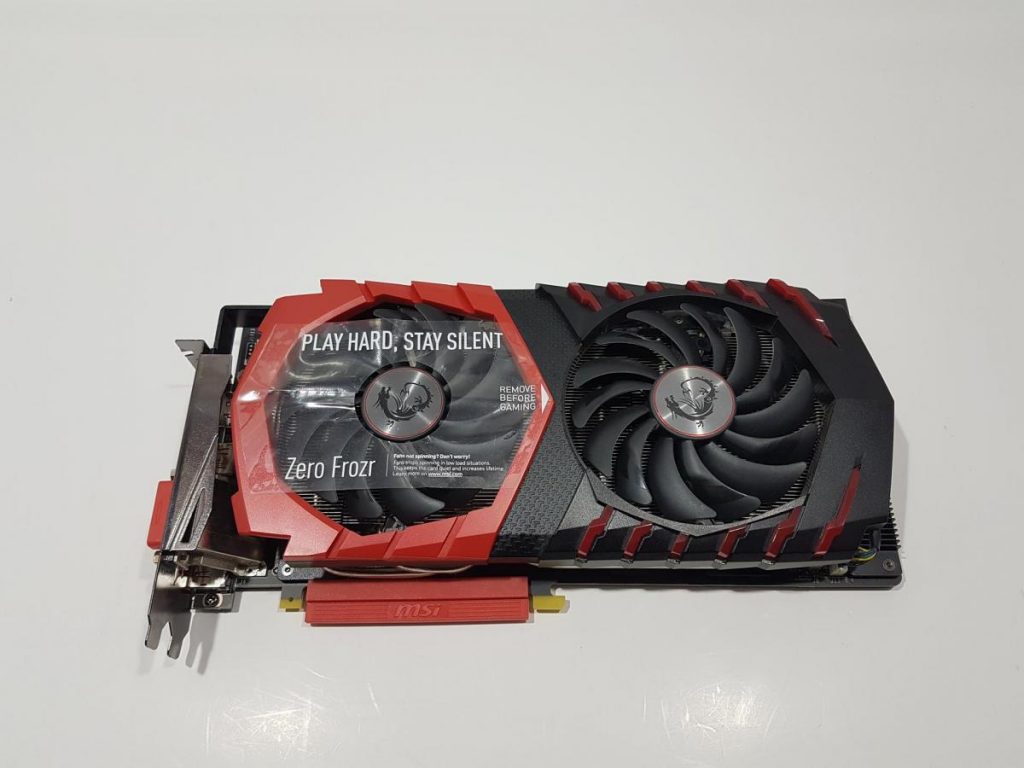
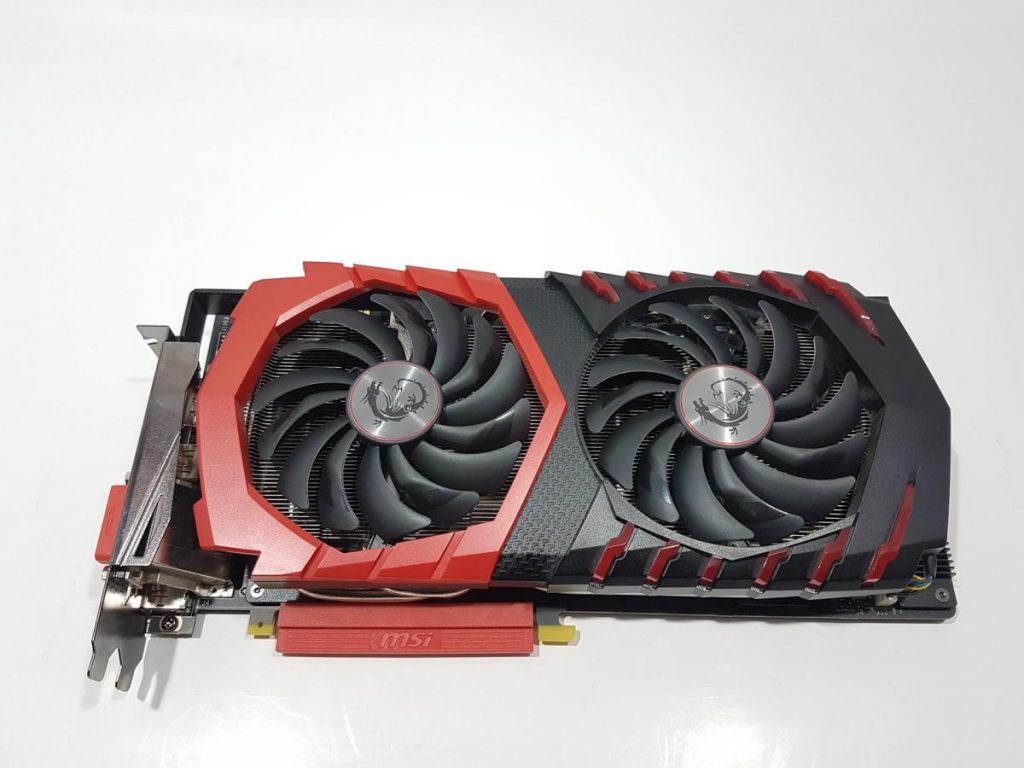
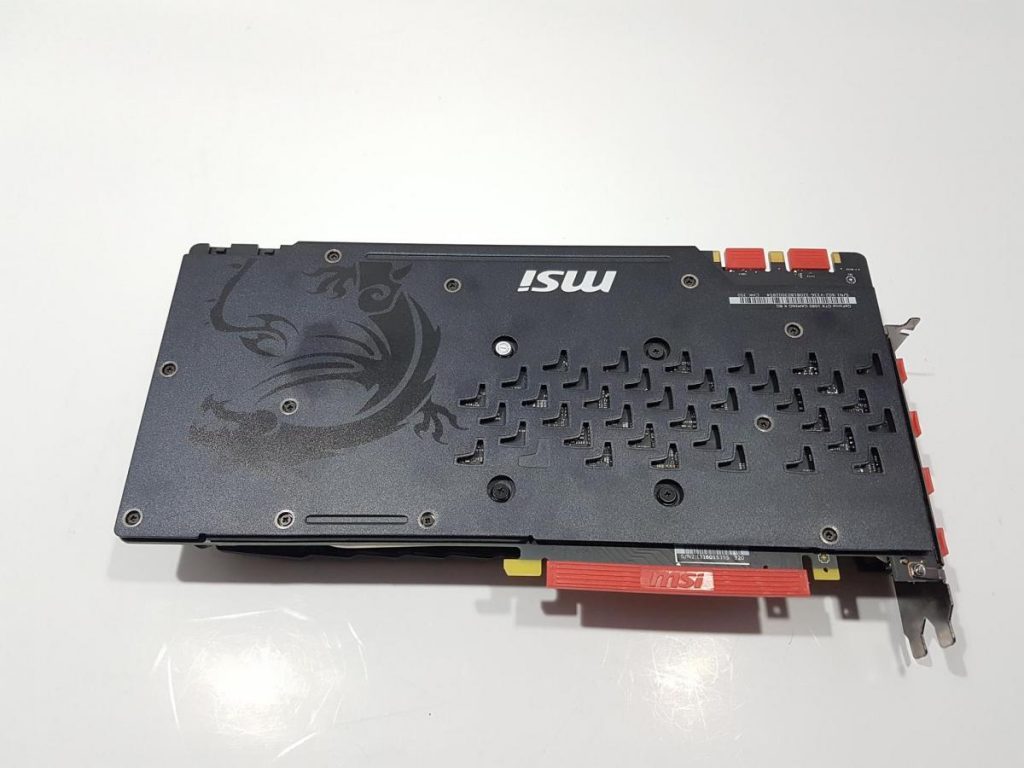
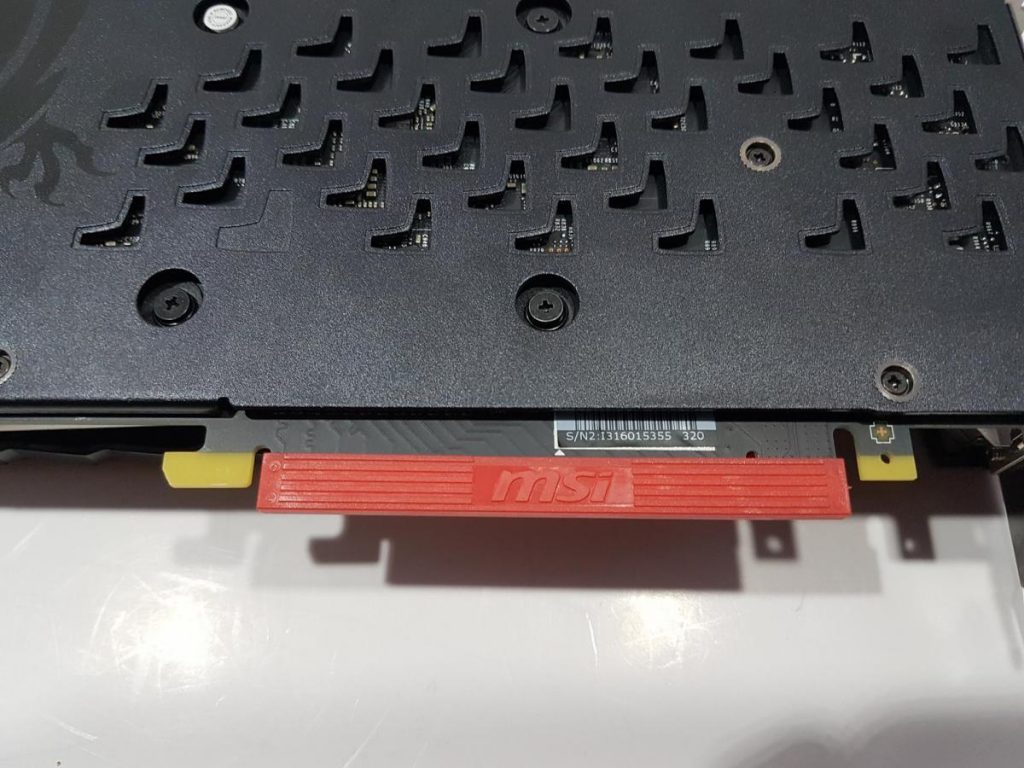
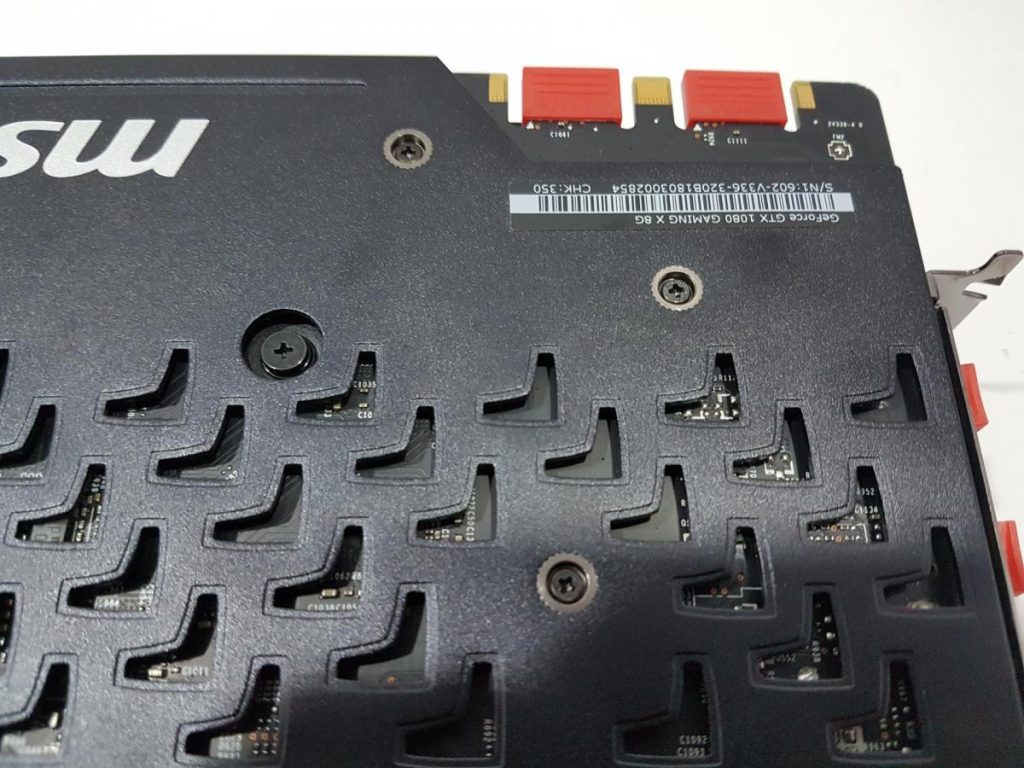

This card weighs 1100gm and measures 279x140x42mm (LxHxW). It features MSI’s distinctive design with a black and red plastic shroud that has a bold and aggressive look. The shroud is two-toned, with the right side in red and a pointy arrow design. The red side is raised, and there’s a continuous recess from the front to the rear. Cutouts on the top and bottom frames, along with a textured pattern, add to the design.
The left side frame gives the impression of a unibody design. There are 6 raised red frosted diffusers on the top and bottom, illuminated by Red LEDs, creating a visually stunning effect. The card follows a red and black theme that complements setups like the PrimoChill Praxis Wetbench.
Equipped with MSI’s Twin Frozr VI cooling solution, the card features TORX 2.0 Fan design with two 95mm fans having 14 blades each. The blades have air channels near the tip for accelerated airflow. The double ball bearings contribute to long-term fan usage and reduced noise for better gaming acoustics. The ZeroFrozr technology ensures the fans start spinning only when the GPU temperature exceeds 60°C, a feature introduced by MSI in 2008.





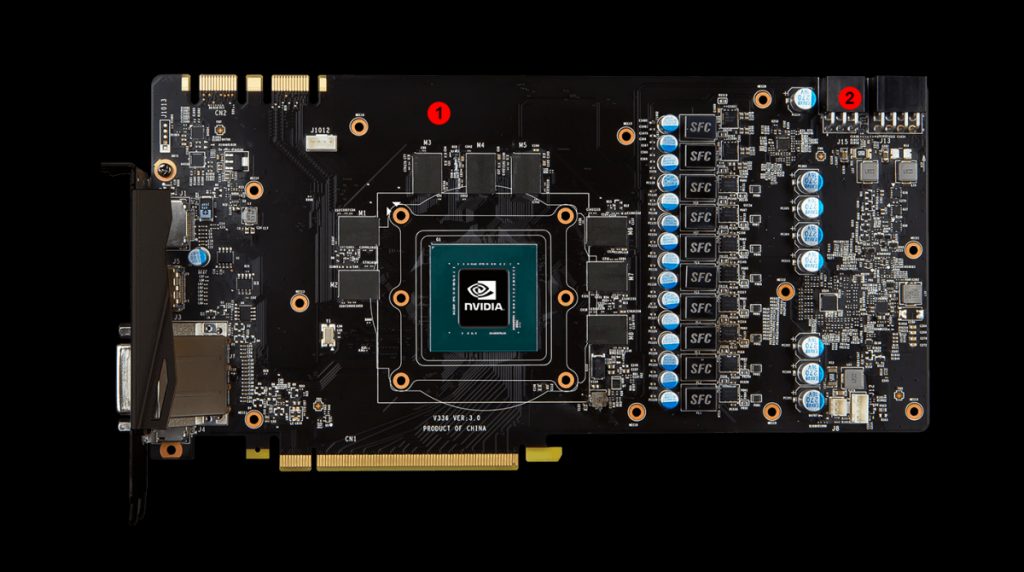
The cooling solution features a single aluminum heatsink spanning the PCB’s length with dense fins, utilizing Airflow Control Technology for targeted cooling. The heatsink incorporates 5 8mm nickel-plated copper heat pipes for efficient heat dissipation. Notably, the middle section is raised, enhancing surface area, while the sides follow a recessed design.
The square-designed heat pipes in contact with the base plate aim to minimize gaps. A nickel-plated copper base plate transfers heat from the GPU to the heat pipes. Premium thermal paste is applied, although the specific type is unverified.
Additionally, a cold plate covers VRAM and surrounding areas for stable overclocking. An anti-bending strip secures the top rear PCB, and a PWM heatsink with micro fins maintains VRM temperatures. The PCIe connector, covered by a red MSI-printed cap, should be removed before installation. Two white headers include a 4-pin PWM for fans and a two-pin LED connector.
The front reveals the PWM heatsink, its rounded edges prioritizing user safety, with the rightmost side visible beneath the shroud. In sum, MSI’s GTX 1080 Gaming X 8G graphics card employs a comprehensive cooling solution for optimal performance.
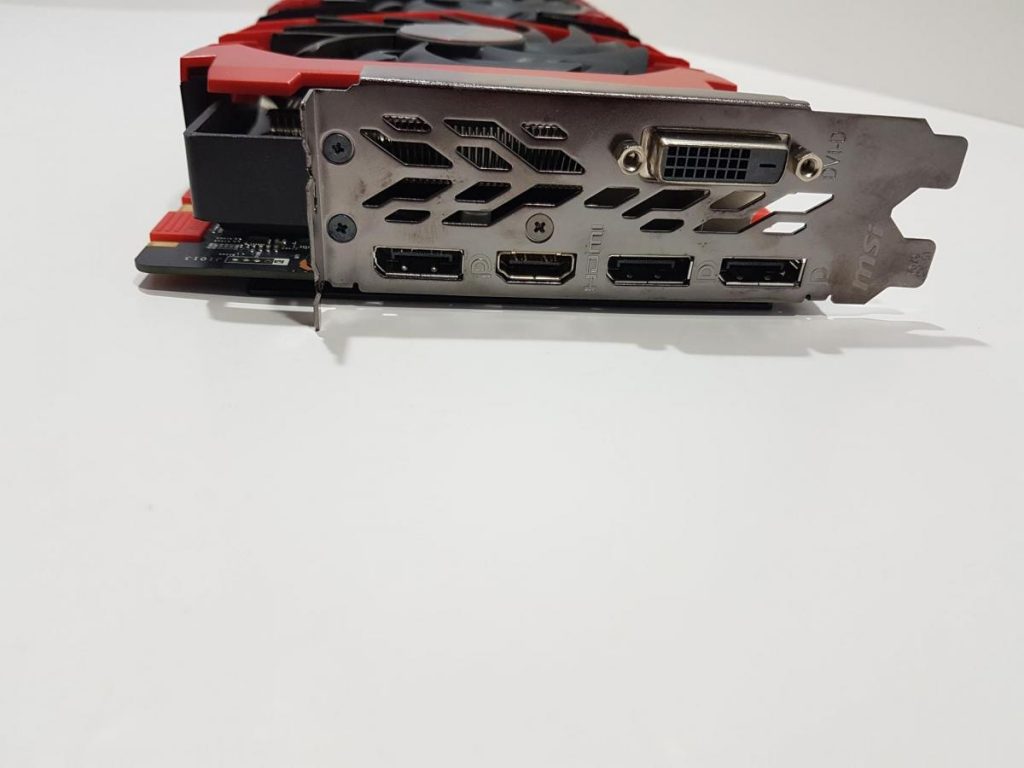

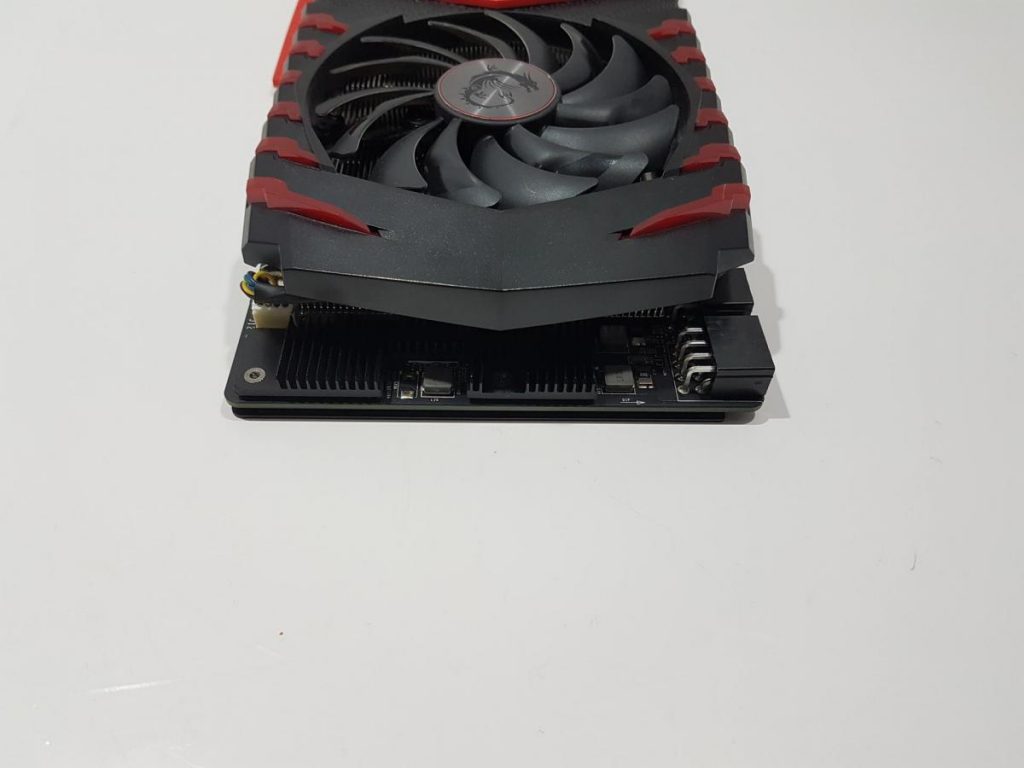
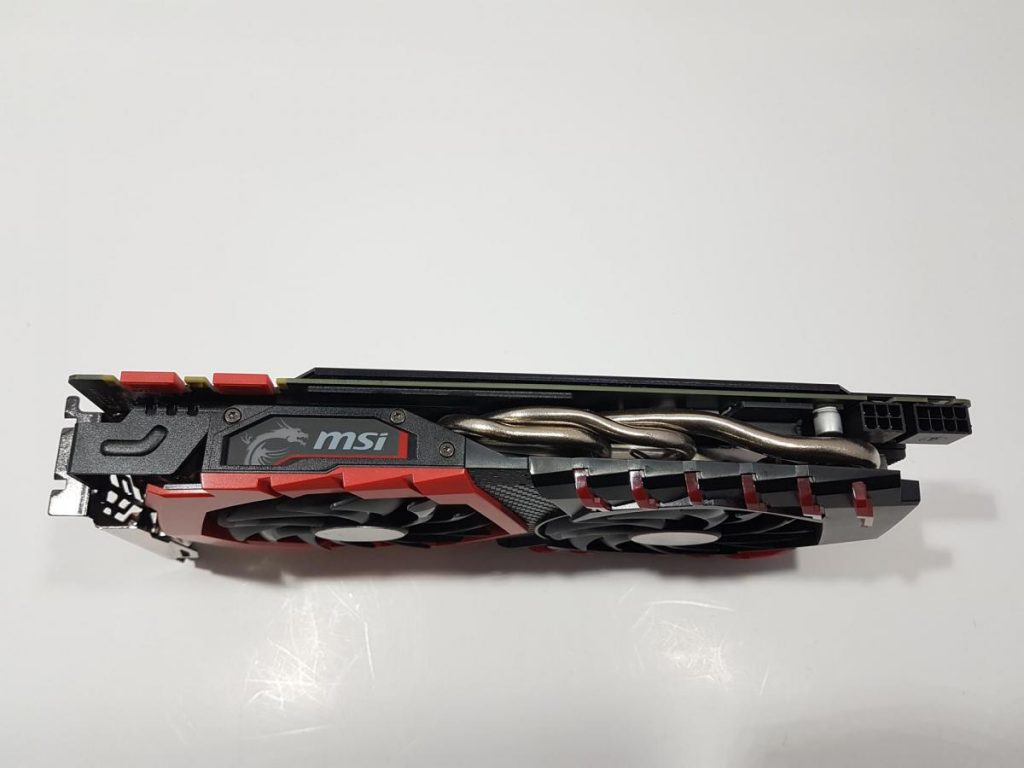
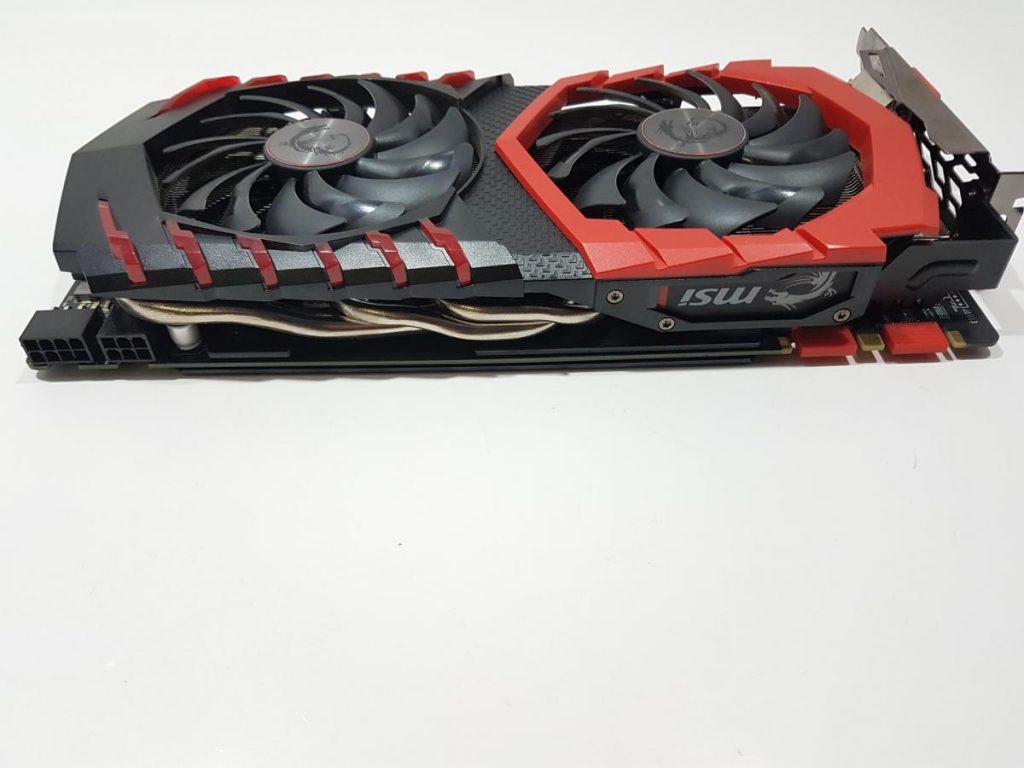
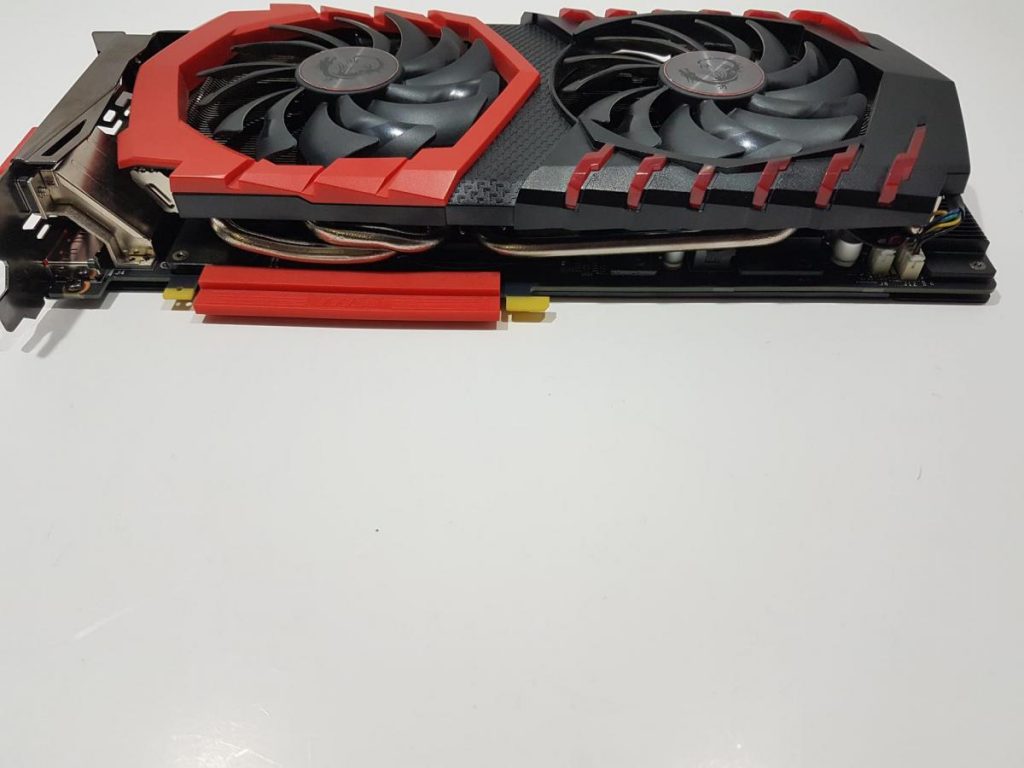
Looking at the top side of the card, there’s an 8-Pin and a 6-Pin connector on the far right, totaling a power draw of 180W. The latches face the PCB side. Noteworthy features include three large heat pipes and a black cold plate between the heatsink and the PCB.
The rear side boasts an RGB lighting area with a dragon image and MSI text, controllable through the Mystic Lighting app. An anti-bending strip runs from the cold plate to the rear IO plate. Two SLI fingers with red hardcovers are visible, and a dragon logo is on the backplate near the power connectors. Vents on the GPU die’s backside extend to the rear IO plate.
A serial number sticker is under the SLI fingers, and four spring-loaded screws secure the cooler’s baseplate to the GPU die. One screw has a white sticker, tampering with it voids the warranty—a practice I find puzzling, as EVGA doesn’t use such stickers, supporting water cooling enthusiasts. Returning to design, the rear side has a standard IO panel with various connectivity options:
- 1x DL-DVI-D Connector
- 1x HDMI Connector 2.0b
- 3x DisplayPort Connectors 1.4
These connectors are protected with red color covers. The maximum digital resolution supported on this card is 7680×4320. This card supports OpenGL 4.5 and DirectX 12. It has two way SLI capability and supports up to 4 displays at a time. It is VR ready and supports GSync as well as adaptive vertical sync. It has HDCP 2.2 support.
Last but not least, MSI is using 10 phase PWM design with Military Class 4 grade components in the power delivery section of the PCB like Super Ferrite Chokes, Hi-C Caps, and Japanese Solid Caps all there to ensure the extreme yet stable overclocking and enhanced efficiency. Before wrapping it up, here are the minimum system requirements:
- PCIe compliant motherboard with one dual-width x16 slot
- One 6-pin and one 8-pin supplementary connectors
- Minimum 500W PSU
- 350MB of free disk storage
- 8GB System Memory
- Microsoft Windows 7, 8, 10
- Internet Connection to download apps from MSI and updated driver from GeForce website.
Test Bench
Following test bench setup was used to test the performance of the graphics card:- Intel i7 6850k
- Asus Rampage V Edition 10
- Ballistix Elite 4x8GB @ 3000MHz
- Noctua NH-D15
- Corsair AX1200i
- Samsung 840 EVO 250GB SSD for OS
- Samsung Barracuda 2TB
- PrimoChill Praxis Wetbench
The CPU is overclocked to the 4.2GHz to avoid any bottlenecking. Following games have been tested:
- Battlefield 1 [DX11, DX12]
- DOOM [Vulkan]
- Grand Theft Auto V
- Metro Last Light Redux
- The Witcher 3
- The Rise of the Tomb Raider [DX11, DX12]
- Mass Effect Andromeda
- Watch Dogs 2
- Call of Duty: WWII
- Wolfenstein II The New Colossus [Vulkan]
Microsoft Windows 10 x64 version 1702 was used. Nvidia graphics driver version 388.13 were used. In case you are wondering why not the latest drivers then there is a simple reason. The previous cards were tested on this driver and unfortunately those samples were returned to their respective sources hence it was only logical to use this driver for better comparison and reference. FPS were monitored using MSI After Burner 4.50. Game settings were set from within the games, not from the GeForce Experience. All the reported framerates are average as reported by the software.
Following synthetic benchmarks were used:
- 3dMark
- Unigine Superposition
Let’s take a look at performance graphs.
3dMark
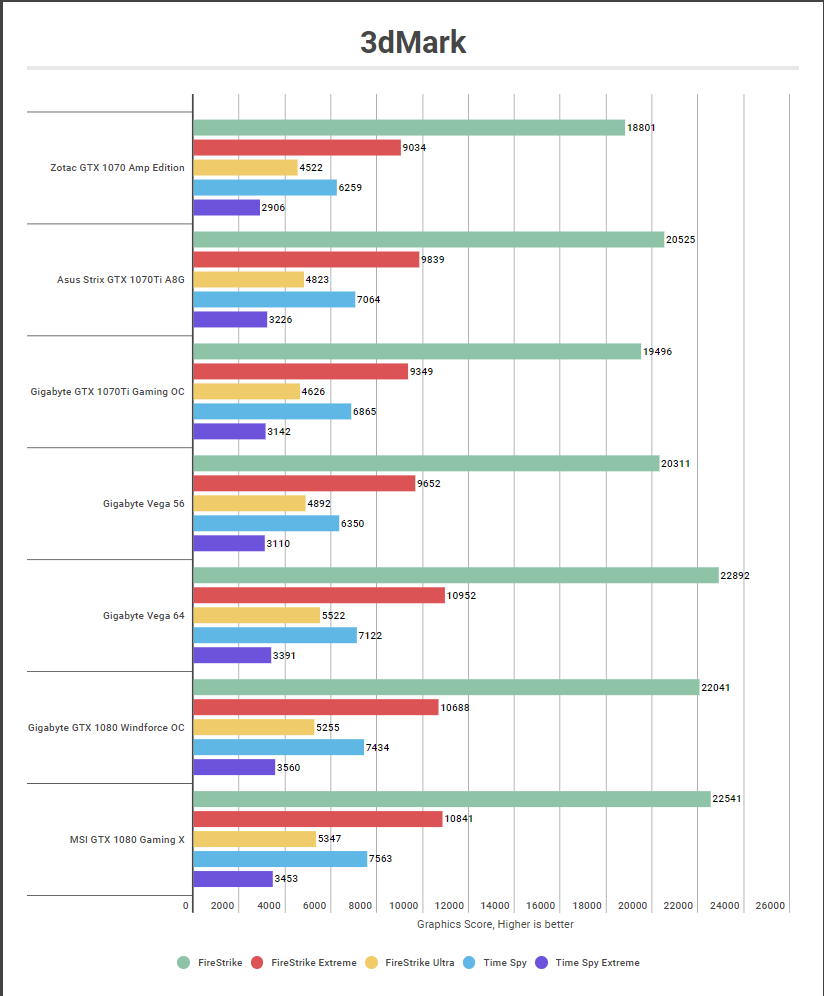
The MSI GTX 1080 Gaming X 8G was trailing behind the Gigabyte Vega 64in FireStrike, FireStrike Extreme, and FireStirke Ultra. But it was the other way around in the TimeSpy bench.
Unigine Superposition

On the 1080P Extreme bench, the Gigabyte RX Vega 64 has outshined both the GTX 1080s. But in 4K optimized and the 8k optimize benches the MSI GeForce GTX 1080 Gaming X 8G takes the lead.
Battlefield 1 DX11
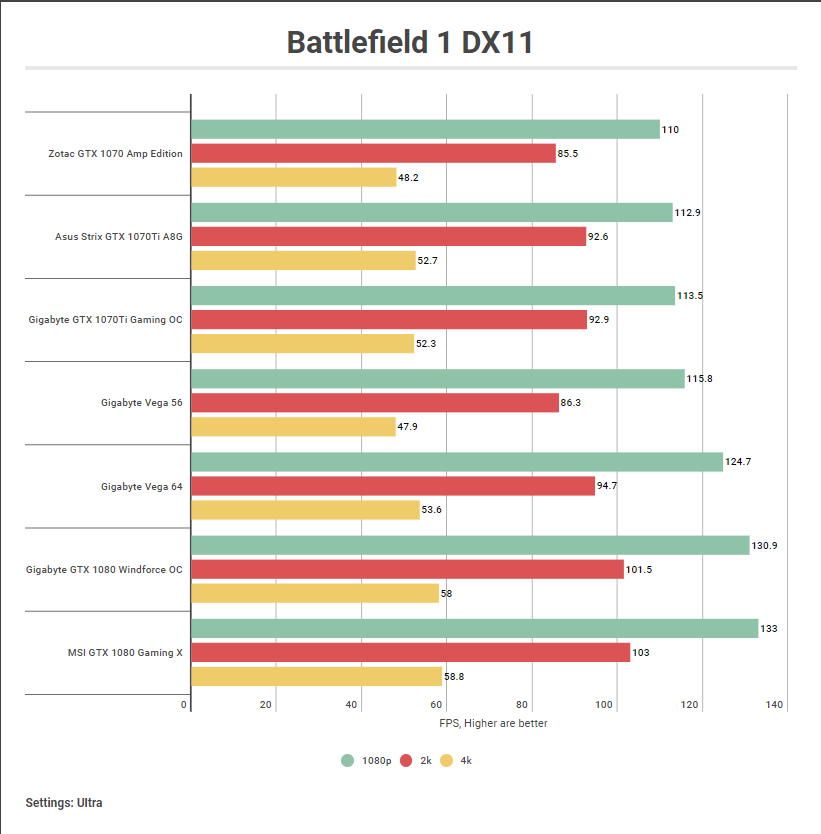
The MSI GTX 1080 Gaming X 8G has outperformed all the graphics cards tested and even on 4k, FPS was just shy of 1.2 marks to get to the magic figure of 60 FPS.
Battlefield 1 DX12

Under DX12 the Gigabyte RX Vega 64 takes the crown though on 1440P the MSI GTX 1080 Gaming X 8G has the lead.
DOOM
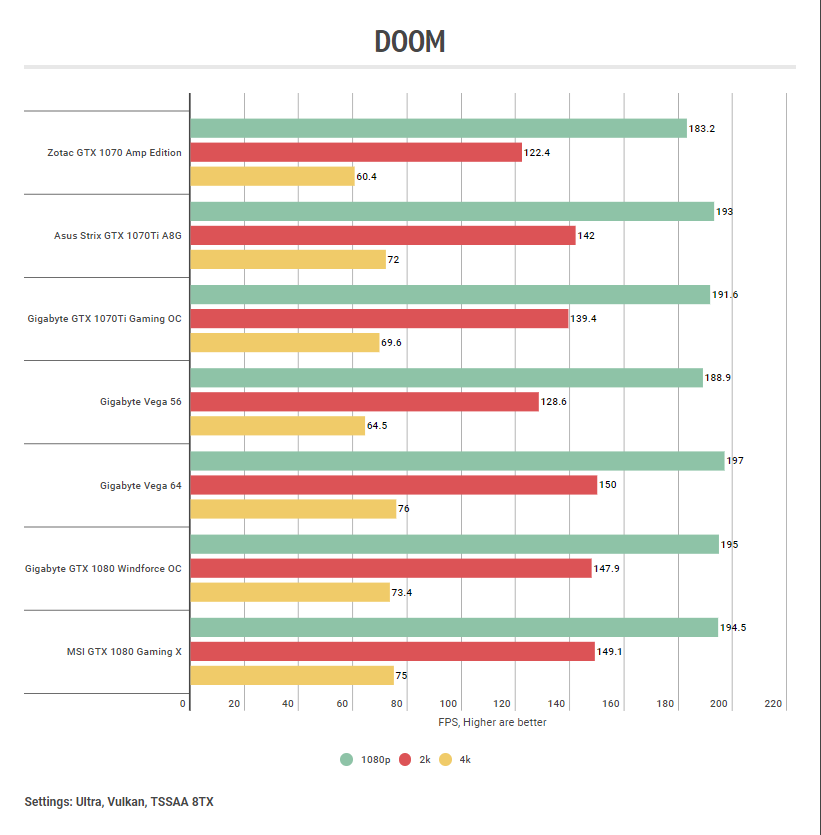
DOOM was tested using Vulcan API and Ultra settings using TSSAA 8TX. As expected the Gigabyte Rx Vega 64 has the lead on all the cards.
Metro Last Light Redux

Metro Last Light Redux was tested on maxed out settings. The MSI GTX 1080 Gaming X 8G has taken a lead over all the cards though there is a marginal gain on the 1440P and 2160P resolutions against the Gigabyte Rx Vega 64.
Grand Theft Auto – V
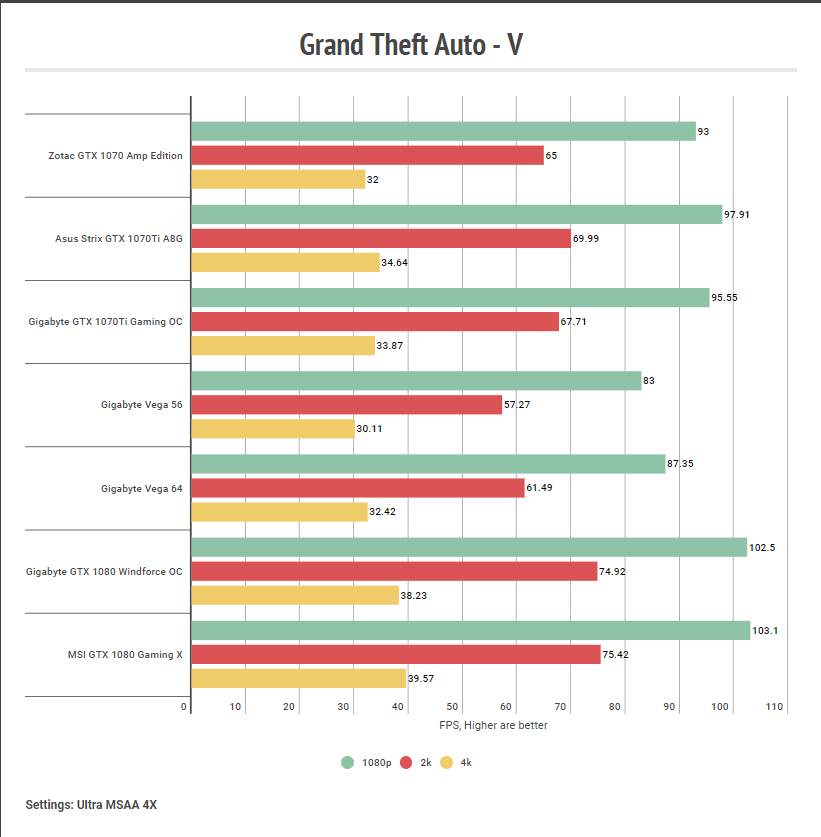
Grand Theft Auto – V was tested with maxed out settings on Ultra with 4x MSAA. The MSI GTX 1080 Gaming X 8G has an overall lead with a marginal lead over the Gigabyte GTX 1080 Windforce OC edition.
Mass Effect Andromeda
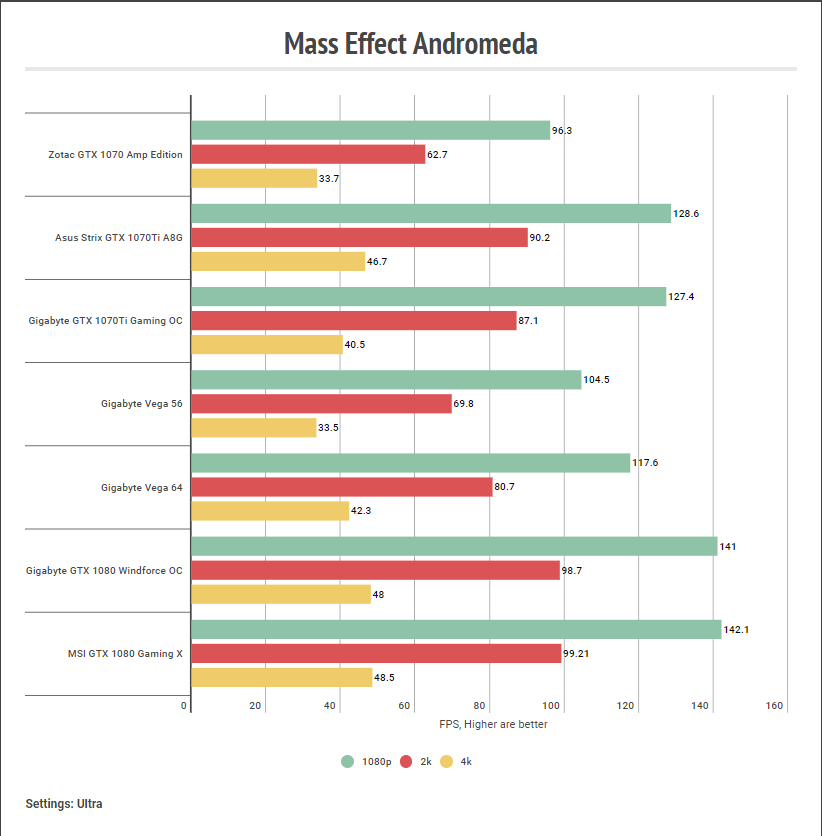
This game was tested with maxed out settings and The MSI GTX 1080 Gaming X 8G has an overall lead with a marginal lead over the Gigabyte GTX 1080 Windforce OC edition. The Gigabyte RX Vega series cards have struggled in this game. Both cards were tested 3 times each to verify the results.
Call of Duty: WWII
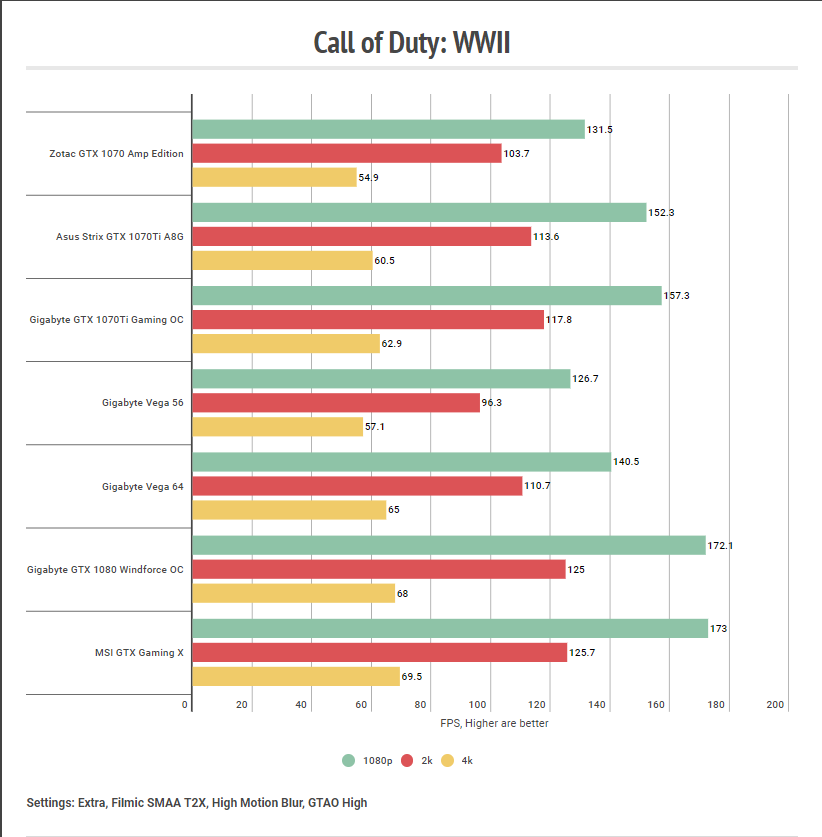
This game was tested with maxed out settings and the MSI GTX 1080 Gaming X 8G has an overall lead over the other cards tested with a marginal lead over the Gigabyte GTX 1080 Windforce OC edition. The Gigabyte RX Vega series cards have struggled in this game. Both cards were tested 3 times each to verify the results.
Wolfenstein II The New Colossus

Both Vega cards have the solid lead with the Gigabyte RX Vega 64 smashing the competition. MSI GTX 1080 Gaming X 8G was marginally behind the Gigabyte GTX 1080 Windforce OC edition.
The Rise of the Tomb Raider DX11

The MSI GTX 1080 Gaming X 8G takes the lead over all the other cards in the graph.
The Rise of the Tomb Raider DX12
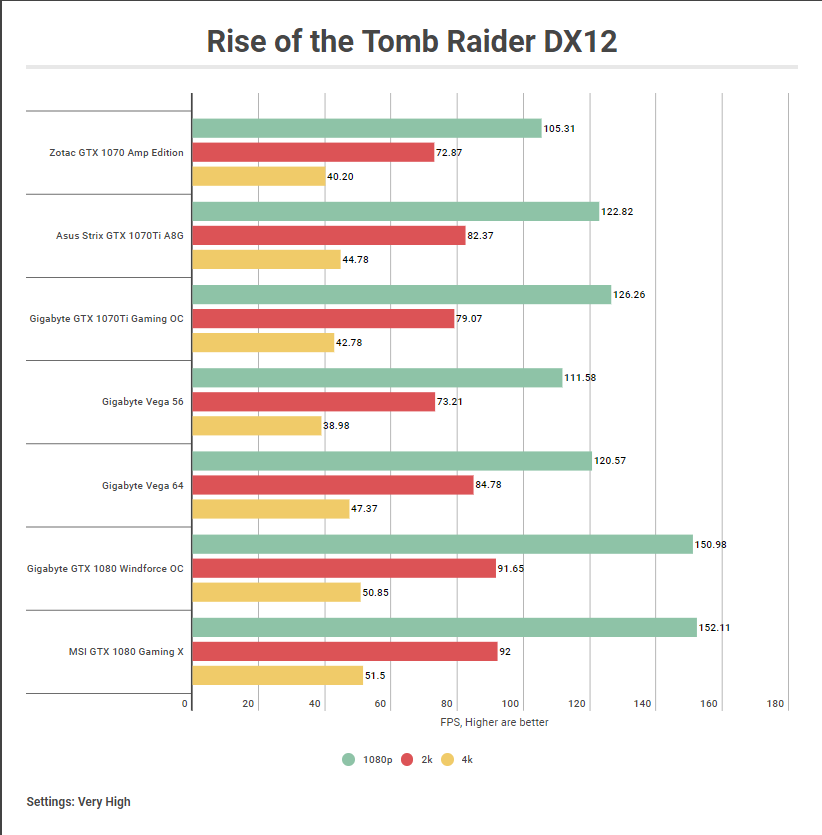
Vega cards could not deliver against our expectations. Just to verify the results, both the Vega cards were tested three times each. The MSI GTX 1080 Gaming X 8G takes the lead over all the other cards in the graph.
The Witcher 3
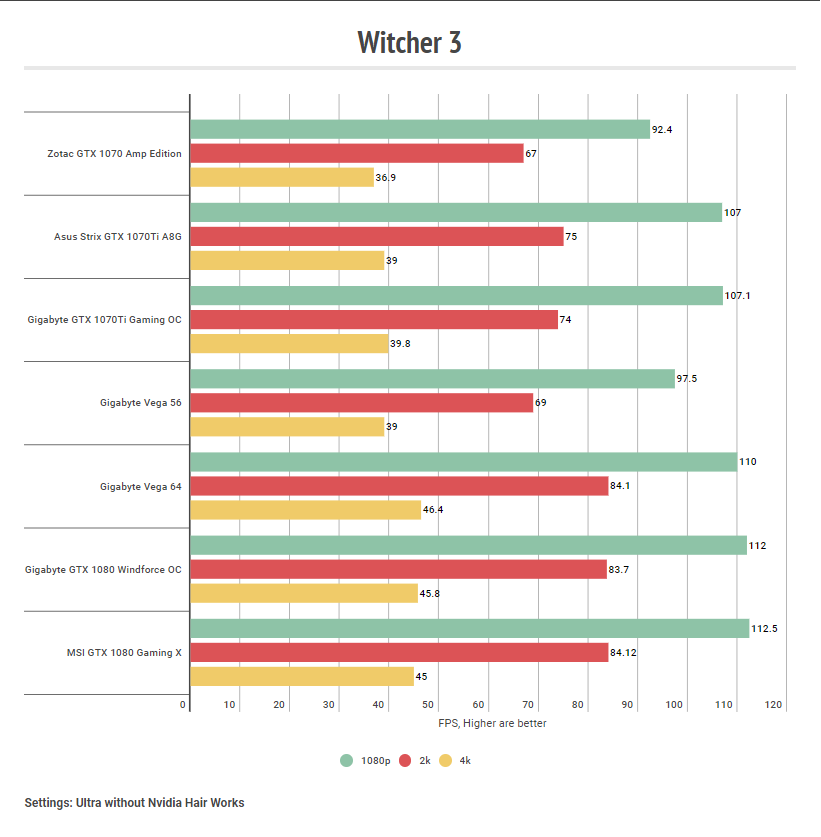
On Ultra settings without Nvidia’s Hairworks, the MSI GTX 1080 Gaming X 8G has an overall lead though it is marginal when it comes to comparing with the Gigabyte RX Vega 64.
Watch Dogs 2
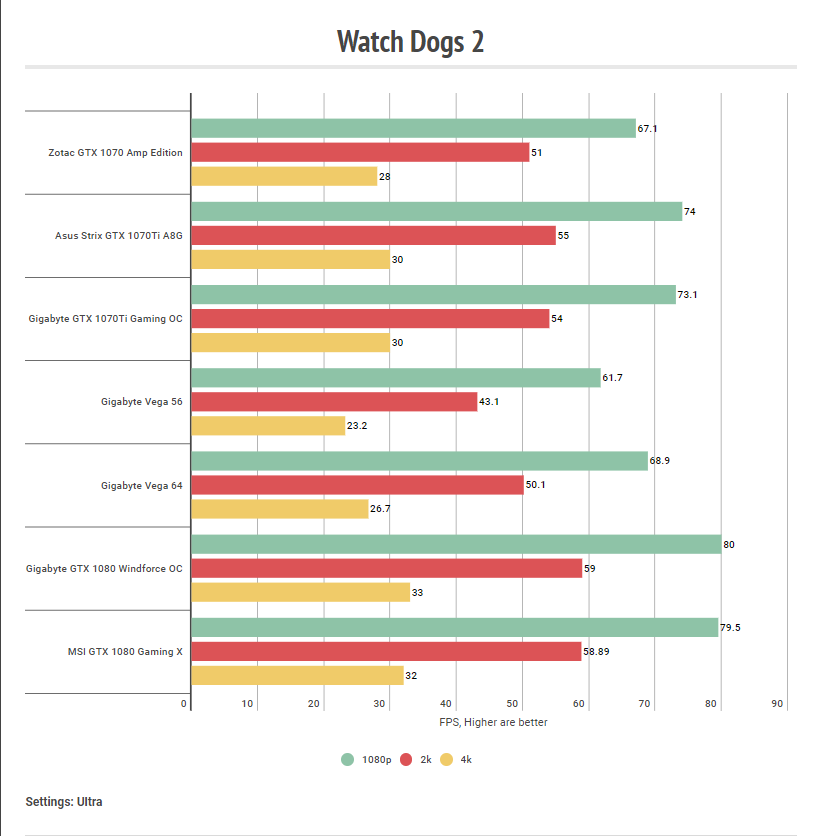
Both GTX 1080 were neck to neck with Gigabyte GTX 1080 Windforce OC edition taking a marginal lead.
Overclocking
The MSI GTX 1080 Gaming X 8G is a factory overclocked card with OC mode. On stock settings, the card has boosted to 1911MHz. Maximum boost during overclocking session was 2076MHz though it was not unstable. The maximum stable overclocked boost clock was 2038MHz.
| Boost Clock on Stock | 1878MHz |
| Boost Clock with OC | 2038MHz |
Here is the result of various testing frequencies and their results:
| Core Clock (MHz) | Memory Clock (MHz) | Voltage (%age) | Boost Clock (MHz) | Test Result |
| +50 | +100 | 40 | 1974 | Passed |
| +100 | +200 | 40 | 2038 | Passed |
| +125 | +300 | 100 | 2076 | Failed |
| +125 | +200 | 100 | 2076 | Failed |
| +120 | +300 | 100 | 2063 | Failed |
| +110 | +300 | 100 | 2050 | Failed |
| +105 | +300 | 100 | 2040 | Passed but overall score was lower than the higher stable OC. |
| +100 | +400 | 100 | 2038 | Passed |
| +100 | +500 | 100 | 2038 | Failed |
| +100 | +450 | 100 | 2038 | Passed |
Here are the results of the synthetic benchmarks and gaming performance with overclocked graphics card:
Superposition
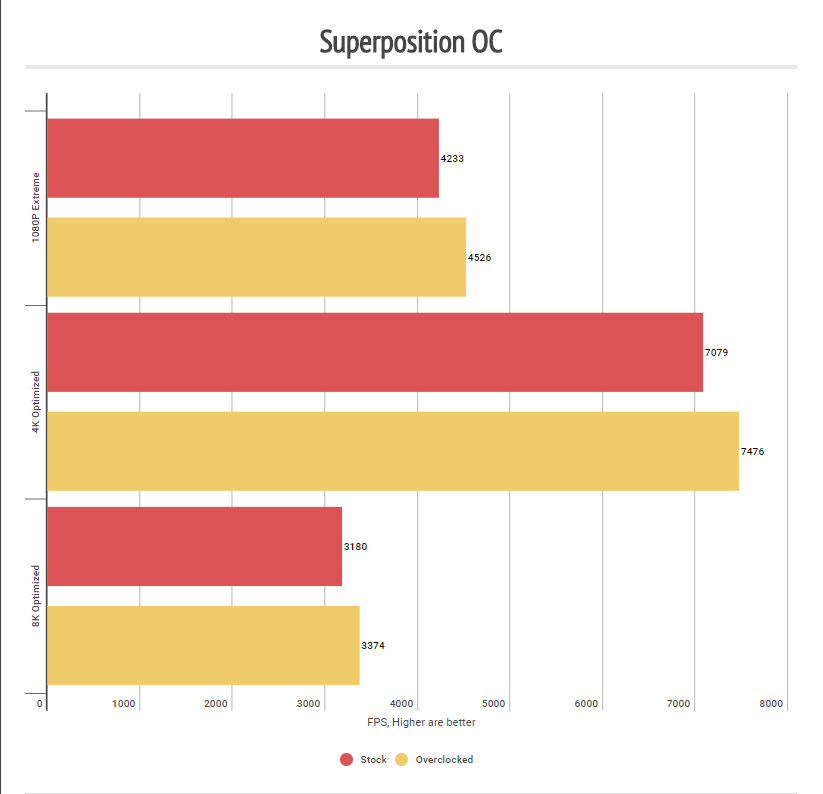
We gain approximately over 5% gain in performance.
Battlefield 1

With overclocking there was a gain of mere 3.75 FPS which is marginal.
Acoustics
The summer season is at its peak here. There are certain environmental noises that are beyond our control. Hence, we will be giving our judgment based on our experience with the fans and other graphics cards. Fans were left on default fan curve. The fans were not that audible during the gaming session and MSI claims of silent operations hold sits ground.
Thermals
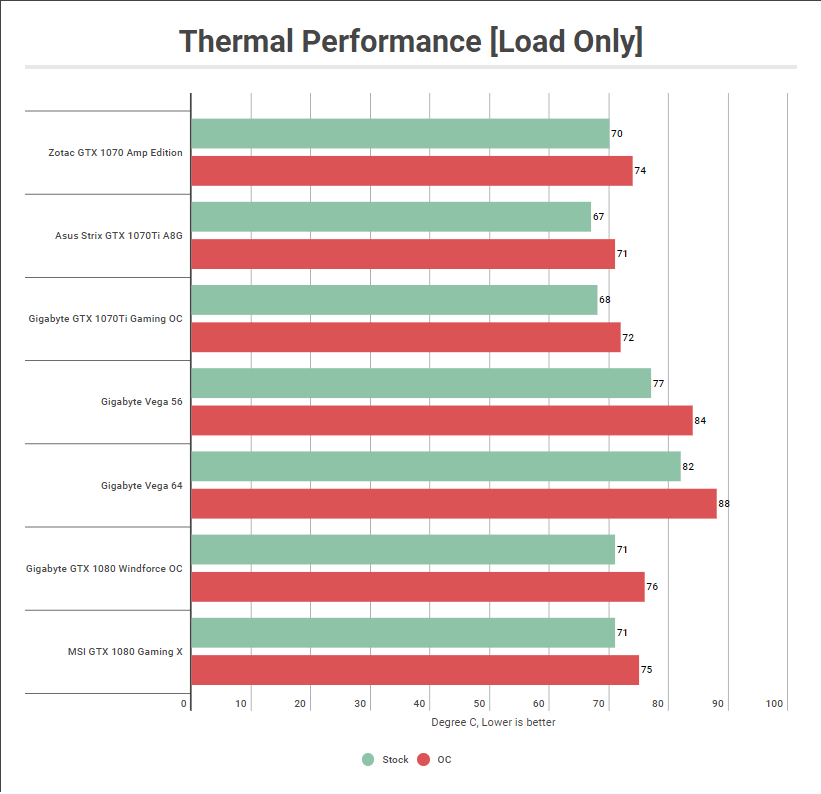
Room temp was 37°C at the time of the testing. The card was tested on the open air bench setup. 71°C was hit under load on the stock clocks whereas 75°C was hit with overclocking. This is a good thermal performance.
Power Consumption
The Corsair AX1200i is a digital PSU with monitoring enabled on the power consumption. Corsair Link was used to checking the power consumption under stock clocks and overclocked clocks. Furmark and AIDA64 were run at the same time to check the combined power consumption of the system. This represents the worst case scenario when it comes to the power consumption.

The MSI GTX 1080 Gaming X features NVIDIA’s Pascal-based GP104 chip with 16nm FinFET technology. It has 2560 unified shaders, a PCIe 3.0 x16 interface, and 7200M transistors. The 8GB GDDR5X memory clocked at 1251MHz provides a bandwidth of 320.3 GB/s on a 256-bit bus. The card’s clock speeds range from 1683MHz base to 1823MHz boost, with three modes (Gaming, OC, and Silent) accessible through the Gaming App.
Weighing 1100g with dimensions of 279x140x42mm, the bold design features red and black shrouds with diffusers and red LEDs. The Twin Frozr VI cooling system includes two 95mm fans with TORX 2.0 technology, and ZeroFrozr ensures fans stay inactive below 60°C. The aluminum heatsink incorporates five 8mm heat pipes, a nickel-plated copper base plate, and a cold plate for VRAM. A 10-phase power design with Military Class 4 components requires a 6-pin and an 8-pin power connector.
Connectivity includes DL-DVI-D, HDMI 2.0b, and three DisplayPort 1.4 ports. The card supports up to 4 displays, VR, GSync, adaptive vertical sync, and has RGB LEDs. Priced at $567, it offers value post-mining price stabilization, excelling in 2K gaming. The MSI Gaming App and Mystic Lighting App allow easy customization. Overall, the MSI GTX 1080 Gaming X is a compelling choice for gamers.
MSI GTX 1080 Gaming X 8G Graphics Card
Design - 9.5
Performance - 9
Value - 9
Quality - 9
9.1
Recommended
Thanks! Do share your feedback with us. ⚡
How can we make this post better? Your help would be appreciated. ✍



